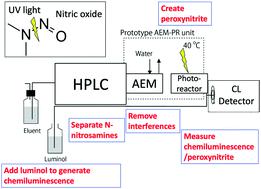当前位置:
X-MOL 学术
›
Environ. Sci.: Water Res. Technol.
›
论文详情
Our official English website, www.x-mol.net, welcomes your
feedback! (Note: you will need to create a separate account there.)
Validation of a novel direct-injection chemiluminescence-based method for N-nitrosamine analysis in advanced-treated recycled water, drinking water, and wastewater
Environmental Science: Water Research & Technology ( IF 3.5 ) Pub Date : 2020-02-27 , DOI: 10.1039/c9ew00943d Shannon L. Roback 1, 2, 3, 4 , Hitoshi Kodamatani 5, 6, 7, 8, 9 , Takahiro Fujioka 9, 10, 11, 12, 13 , Megan H. Plumlee 1, 2, 3, 4
Environmental Science: Water Research & Technology ( IF 3.5 ) Pub Date : 2020-02-27 , DOI: 10.1039/c9ew00943d Shannon L. Roback 1, 2, 3, 4 , Hitoshi Kodamatani 5, 6, 7, 8, 9 , Takahiro Fujioka 9, 10, 11, 12, 13 , Megan H. Plumlee 1, 2, 3, 4
Affiliation

|
N-Nitrosamines are water contaminants of public health concern due to their carcinogenicity at low concentrations. These compounds can form in wastewater and drinking water when chloramination is utilized for disinfection. Monitoring of N-nitrosamines by current analytical techniques is difficult, time-consuming, and expensive. Therefore, a simpler method developed in 2009 utilizing high-performance liquid chromatography (HPLC) with detection by photochemical reaction (PR) and chemiluminescence (CL) and requiring almost no sample preparation (no extraction) was tested and validated in the present study for potable reuse applications. The method accuracy, precision, and detection limits were determined using standard methods. Accuracy and precision met U.S. EPA standard method requirements for four N-nitrosamines [N-nitrosodimethylamine (NDMA), N-nitrosopyrrolidine, N-nitrosomorpholine, and N-nitrosomethylethylamine] in the four recycled water matrices tested: (1) secondary wastewater effluent, (2) microfiltered wastewater effluent, (3) advanced purified water (after reverse osmosis and ultraviolet/advanced oxidation), and (4) ultrapure (Milli-Q) water. Method reporting (MRL) and detection limits (MDL) were similar or lower (1.2 ng L−1 MRL for NDMA) than those documented for conventional N-nitrosamine analytical methods (typically 2 ng L−1 MRL for NDMA). Split samples were collected from an advanced water purification facility weekly over six months and less frequently from four additional water utilities and analyzed by the HPLC-PR-CL method and conventional methods employed by the utility's laboratory (liquid- or solid-phase extraction/gas chromatography/dual mass spectrometry). The relative percent difference for all non-wastewater samples was low (6–18%) with wastewater effluent samples having a higher difference (11–53%).
中文翻译:

验证了一种基于直接注射化学发光的新型方法,用于处理后的循环水,饮用水和废水中的亚硝胺
N-亚硝胺是低浓度的致癌物质,是公众健康关注的水污染物。当将氯化作用用于消毒时,这些化合物会在废水和饮用水中形成。监测氮用当前的分析技术制备亚硝胺是困难,费时和昂贵的。因此,在本研究中测试并验证了2009年开发的一种更简单的方法,该方法利用高效液相色谱(HPLC)以及通过光化学反应(PR)和化学发光(CL)进行检测并且几乎不需要样品制备(无需提取)的方法。重用应用程序。使用标准方法确定方法的准确性,精密度和检测限。准确度和精度满足美国EPA标准方法要求进行4个Ñ -nitrosamines [ Ñ -nitrosodimethylamine(NDMA),Ñ -nitrosopyrrolidine,Ñ -nitrosomorpholine和Ñ-亚硝基甲基乙胺]在以下四个循环水矩阵中进行测试:(1)二级废水流出物,(2)微滤废水流出物,(3)高级纯净水(经过反渗透和紫外线/高级氧化后),和(4)超纯水(Milli-问)水。方法报告(MRL)和检测限(MDL)与常规N-亚硝胺分析方法(通常为2 ng L -1)相近或更低(对于NDMA为1.2 ng L -1 MRL)NDMA的MRL)。在六个月内每周从先进的净水设施中收集的样品样品,从四个额外的水务公司每周一次,收集频率较低,并通过HPLC-PR-CL方法和公用事业公司实验室采用的常规方法进行分析(液相或固相萃取/气体色谱/双质谱法)。所有非废水样品的相对百分比差异较低(6-18%),而废水流出样品的相对百分比差异较高(11-53%)。
更新日期:2020-02-27
中文翻译:

验证了一种基于直接注射化学发光的新型方法,用于处理后的循环水,饮用水和废水中的亚硝胺
N-亚硝胺是低浓度的致癌物质,是公众健康关注的水污染物。当将氯化作用用于消毒时,这些化合物会在废水和饮用水中形成。监测氮用当前的分析技术制备亚硝胺是困难,费时和昂贵的。因此,在本研究中测试并验证了2009年开发的一种更简单的方法,该方法利用高效液相色谱(HPLC)以及通过光化学反应(PR)和化学发光(CL)进行检测并且几乎不需要样品制备(无需提取)的方法。重用应用程序。使用标准方法确定方法的准确性,精密度和检测限。准确度和精度满足美国EPA标准方法要求进行4个Ñ -nitrosamines [ Ñ -nitrosodimethylamine(NDMA),Ñ -nitrosopyrrolidine,Ñ -nitrosomorpholine和Ñ-亚硝基甲基乙胺]在以下四个循环水矩阵中进行测试:(1)二级废水流出物,(2)微滤废水流出物,(3)高级纯净水(经过反渗透和紫外线/高级氧化后),和(4)超纯水(Milli-问)水。方法报告(MRL)和检测限(MDL)与常规N-亚硝胺分析方法(通常为2 ng L -1)相近或更低(对于NDMA为1.2 ng L -1 MRL)NDMA的MRL)。在六个月内每周从先进的净水设施中收集的样品样品,从四个额外的水务公司每周一次,收集频率较低,并通过HPLC-PR-CL方法和公用事业公司实验室采用的常规方法进行分析(液相或固相萃取/气体色谱/双质谱法)。所有非废水样品的相对百分比差异较低(6-18%),而废水流出样品的相对百分比差异较高(11-53%)。











































 京公网安备 11010802027423号
京公网安备 11010802027423号